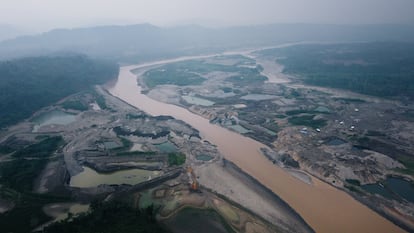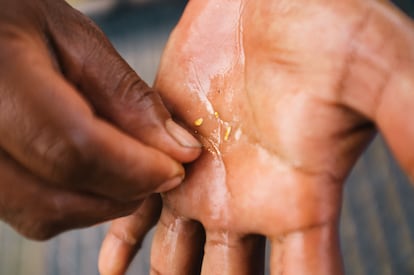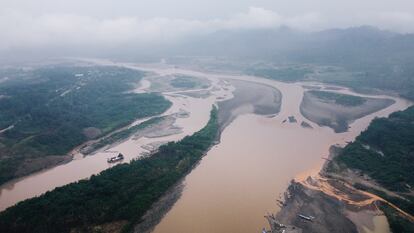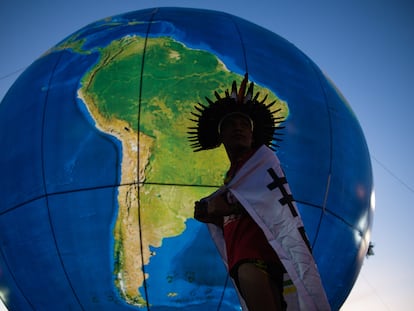Bolivia’s mercury dilemma: The metal that both feeds and poisons the country’s Amazon region
A study of over 300 people reported high levels of this toxic material, which miners use to extract gold from the rivers that supply water and food to the communities

Indigenous peoples including the Esse Ejja, Lecos, Mosetenes Chimanes, Tacanas and the Uchupiamona have lived in the Bolivian Amazon for centuries. But now they are threatened by mercury contamination, especially in the Beni and Madre de Dios rivers, where Amazonian communities catch the fish that form the basis of their diet. Concerned about this situation, the indigenous peoples who belong to the National Coordinating Committee for the Defense of Native Indigenous Peasant Territories and Protected Areas (Contiocap) sought help from the Bolivian Documentation and Information Center (Cedib) to find out what was happening.

The groups contacted the School of Toxicology at the University of Cartagena in Colombia, which conducted 350 hair tests on members of various communities. The results showed an average of seven parts per million (ppm) of mercury, which is seven times above safe levels, according to the World Health Organization (WHO).
Colombian scientist Jesús Olivero took the samples and presented the results of the study before the Inter-American Commission on Human Rights (IACHR) last year. In his report, he noted that they evaluated indigenous people’s health through surveys and “the reports of memory loss, hand tremors and sensory problems for a good number of people, especially those with high levels of mercury contamination, were remarkable.”
Mercury is an extremely dangerous metal. Exposure to it causes serious illnesses, which can be particularly lethal in children and pregnant women. “I feel annoyed, violated. In Bolivia, we were completely unaware of how mercury was being used. The communities complained that health problems caused by the contamination began to appear, such as skin problems, diarrhea in children and miscarriages in women, symptoms and effects that they claim weren’t problems before,” says Ruth Alipaz, the leader of Contiocap and an advocate of indigenous territories and environmental rights in the Bolivian Amazon.
Alipaz was born in the community of San José de Uchupiamonas, in the north of the department of La Paz, which is home to some 80 families; most residents there live in mud houses with roofs made of jatata, a palm tree species native to the area. When she had a test done in 2019, Alipaz had twice the tolerable level of mercury in her body.
“I have had new tests that indicated that my mercury levels continue to increase. I have had chronic diarrhea since 2019,” Alipaz says.
Researchers warn that the contamination could extend to all Amazon basin communities with cooperative miners who use mercury in the area to separate and extract gold from rocks or stones in the rivers. After using it, the miners throw the mercury into the rivers, contaminating the fish in violation of local regulations that require them to recycle the toxic metal.
“Scientific evidence has already identified mercury’s impact on fish in the rivers of the Bolivian Amazon Basin. The miners dump mercury into the river until it reaches people through the fish they eat,” says Oscar Campanini, the director of Cedib, who also researches environmental, water, extractivism and human rights issues.
Last year, the Amazonian communities submitted a complaint to the IACHR about the impact of mercury contamination on indigenous peoples’ lives and health. The Organization of American States institution ordered the Bolivian State to present a plan of action for reducing the use and sale of mercury.
Bolivia was one of the 140 countries that signed onto the Minamata Convention on Mercury. Among other provisions, the convention reduces, controls and eliminates the use of mercury in both mining and industry.
To that end, President Luis Arce’s government presented two projects last January. The first, called the National Action Plan (PAN), will be implemented over two years, investing $500,000 for the development of strategies and mechanisms to gradually reduce the use of mercury in mining.
The second initiative is the five-year PlanetGOLD Bolivia project, which has a budget of about $6.5 million to increase access to financing for the adoption of sustainable mercury-free technologies.
Both plans primarily seek to “mitigate the environmental impact of mining activities that use mercury” and to “prevent the use of this resource from affecting Bolivian communities’ living conditions,” said Juan Santos Cruz, the Minister of Environment and Water, at the presentation.
In recent years, gold mining activity has grown exponentially in Bolivia. According to figures from the National Institute of Statistics (INE), in 2020, 25 tons of metallic gold — worth $1.276 billion — were exported, while in 2022 the amount reached 64 tons, worth $3.003 billion.
Former president Evo Morales’s government boosted the growth of cooperative mining companies from around 800 at the beginning of his term in 2006 to some 1,900 at the end of his presidency in 2019. The cooperatives, which are responsible for 94% of gold production in Bolivia, allied themselves with Morales, and the government passed laws that were favorable to them, as in 2016 when Morales relaxed the environmental regulations on this sector and reduced their extraction royalty payments to the state from 7% to 2.5%.

Bolivian streets contaminated by mercury
The gold mining boom also generated more demand for mercury. Three to four tons of this toxic metal are used to produce one ton of gold.
Miners procure the mercury in the cities of La Paz and El Alto, where it is stored and sold without clear regulations. That exposes the more than two million inhabitants of both cities to mercury contamination.
“We are being poisoned [just] by walking on the street. Customs has no special procedure for regulating the mercury imports. [Moreover], there’s no effective control over the use of mercury to extract gold,” says Cecilia Requena, a well-known environmentalist and senator in Bolivia’s Plurinational Legislative Assembly.
Mercury is found in the populous area of Buenos Aires, in western La Paz. That zone is characterized by traffic, shouting merchants and brick and pastel-colored houses. When one goes up some narrow steps, Tarapacá Street opens up; the silence there is a stark contrast with the hustle and bustle of the rest of the place.
There, dozens of jewelry stores, well protected by security cameras, offer mercury in small one-kilo bottles. The white bottles are labeled with the brand name El Español, the one that purchasers of the substance know best.
At jewelry store entrances, one sees small furnaces, oxygen tubes and chimneys facing the street. “We melt mercury in these furnaces. A vapor comes out that goes out through the chimneys, that’s how we work,” María Rojas says untrustingly.
“The mercury is used by the miners who extract gold to the north of La Paz. A kilo can cost up to 2,000 bolivianos (about $286). [The price] has gone up a lot, because there is more control,” says Jorge Aruquipa, holding two small gold bars outside his jewelry shop in a darkened shopping mall.
Bolivia: A major importer of mercury
“Mercury is imported in 44-kilogram containers but selling them in small one-kilogram bottles means that a significant portion is repackaged and, if this activity is not done properly, the area where it is sold is at high risk of contamination,” Campanini says.
In 2015, Bolivia imported 151.5 tons of mercury and a year later, mercury imports reached a record 238.3 tons. In 2020, the country imported 165.2 tons, surpassing countries such as India (113 tons) and the United Arab Emirates (104). That volume made it one of the world’s leading mercury importers, according to a statement from the Vice Ministry of Domestic Trade. Bolivia’s main suppliers are Russia and Mexico.
While the Bolivian government is moving forward on projects to reduce the use of mercury in mining, Senator Requena anticipates that doing so will take several months and progress will depend on state bureaucracy. “The authorities could establish a customs and commercialization control regulation now,” she says.
Meanwhile, indigenous people feel “helpless,” says Ruth Alipaz. She is asking the government to eliminate mercury completely so that other people won’t be poisoned, “because those of us who already [have mercury poisoning] will not be able to remove it from our bodies, and we will have to live with the effects.”
Sign up for our weekly newsletter to get more English-language news coverage from EL PAÍS USA Edition
Tu suscripción se está usando en otro dispositivo
¿Quieres añadir otro usuario a tu suscripción?
Si continúas leyendo en este dispositivo, no se podrá leer en el otro.
FlechaTu suscripción se está usando en otro dispositivo y solo puedes acceder a EL PAÍS desde un dispositivo a la vez.
Si quieres compartir tu cuenta, cambia tu suscripción a la modalidad Premium, así podrás añadir otro usuario. Cada uno accederá con su propia cuenta de email, lo que os permitirá personalizar vuestra experiencia en EL PAÍS.
¿Tienes una suscripción de empresa? Accede aquí para contratar más cuentas.
En el caso de no saber quién está usando tu cuenta, te recomendamos cambiar tu contraseña aquí.
Si decides continuar compartiendo tu cuenta, este mensaje se mostrará en tu dispositivo y en el de la otra persona que está usando tu cuenta de forma indefinida, afectando a tu experiencia de lectura. Puedes consultar aquí los términos y condiciones de la suscripción digital.
More information
Archived In
Últimas noticias
Maduro pleads not guilty before the federal court in New York: ‘I am still the president of Venezuela’
A new test can detect Alzheimer’s from a finger prick
UN team enters Sudanese city of El Fasher after paramilitary massacre: ‘It’s like a ghost town’
A recipe for resistance: Indigenous peoples politicize their struggles from the kitchen
Most viewed
- Gilles Lipovetsky: ‘If you want to live better and fall in love, take Prozac, don’t look to philosophy’
- Alain Aspect, Nobel laureate in physics: ‘Einstein was so smart that he would have had to recognize quantum entanglement’
- Alvin Hellerstein, a 92-year-old judge appointed by Bill Clinton, to preside over Maduro’s trial in New York
- Why oil has been at the center of Venezuela-US conflicts for decades
- Maduro’s downfall puts China’s relationship with Venezuela to the test










































